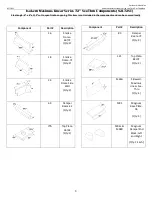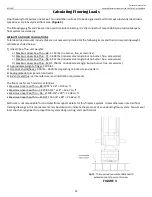
Earthcore Industries
02/2021
Isokern Maximus Linear Series See-Thru Gas Fireplace
3
General Information
Isokern Maximus Linear Series See-Thru Models 82L48ST, 82L72ST, 82L96ST and 82L120ST are tested and listed by PFS
Corp., USA Report No. F19 – 161 to ANSI Z21.50 - 2019 and Canadian Standard CSA 2.22 - 2019. The Isokern Maximus Linear
Series See-Thru fireplaces are top-vented, gas only fireplaces that are listed for use only with the Isoflames Linear Burner gas
appliance listed in this installation manual. These gas appliances come with a gas control valve that includes an automatic
shut-off switch. The gas valve is available in a millivolt remote control pilot assembly.
The exhaust flue gases are to be vented through the top of the unit with listed B-Vent piping. A twelve-inch (12”) diameter,
double wall B-Venting system will terminate with the Enervex 12” Mechanical Fireplace Damper (MFD) and fan combination
as detailed in this manual (RS012, RS014, or RS016). The damper and fan combinations are model specific and are required
for proper operation of all Isokern Maximus Linear models 48, 72, 96 and 120.
WARNING!!!
: This gas appliance must not be connected to a chimney flue servicing a solid fuel burning appliance.
INTENDED USE STATEMENT
The Isokern Maximus Linear Series See-Thru is intended to burn propane (LP) gas or natural gas (NG), only. This appliance is
not intended to be used as a primary source of heat.
The Isokern Maximus Linear Series See-Thru and its approved components are safe when installed according to this
installation manual and when operated as recommended by the manufacturer. Unless you use Earthcore Industries, LLC
approved components tested for this appliance, you may cause a fire hazard or serious injury. Before you begin the
installation of this appliance, read these instructions completely.
Earthcore Industries, LLC disclaims any responsibility for the following actions:
1.
Modification of the appliance or any of its components.
2.
Use of any component part not approved by Earthcore Industries in combination with this appliance.
3.
Installation or operation in a manner other than instructed in this manual.
4.
Burning of anything (solid fuel) other than the listed gas log unit and the type of gas approved for use in this gas
appliance.
The most important areas of concern with the installation of the Isokern Maximus Linear Series See-Thru are clearance to
combustible materials, proper assembly of component parts, load carrying capacity of underlying floor system, heights of
chimney system, hearth extensions, and the techniques employed in applying finishing materials to the wall surrounding the
Isokern Maximus Linear Series See-Thru. Combustion air inlet kits are not required for the Isokern Maximus Linear Series
See-Thru, however may help improve fireplace operation. Check local codes for combustion air requirements.
Each of these topics will be covered in detail throughout this manual. Special attention must be given to each topic as the
installation progresses.
The installation of the Isokern Maximus Linear Series See-Thru must conform with local codes or, in the absence of local
codes, with the current National Fuel Gas Code, ANSI-Z223.1/NFPA 54 or the current Natural Gas and Propane Installation
Code, CSA B149.1.
SEISMIC CODE SPECIFICATIONS
If installation of the Isokern Firebox is to be installed in an area with seismic codes, please follow these instructions. Four #4
ASTM A615 Grade 40 minimum, vertical reinforcing bars, 2 on each side of the firebox running from top of sidewalls to
approximately 4 inches into the concrete slab (for anchorage).
IMPORTANT:
The top plate of the firebox shall not to be used as a structural support. The top plate is not designed to be a
weight / load bearing surface.
NOTE:
Do not scale drawings. Illustrations in this manual are not to scale and are intended to show “typical” installations.
Nominal dimensions are given for design and framing reference only. Actual installations may vary due to job specific design
preferences. Always maintain the stated minimum clearances to combustible materials. Do not violate any specific installation
requirements.




































